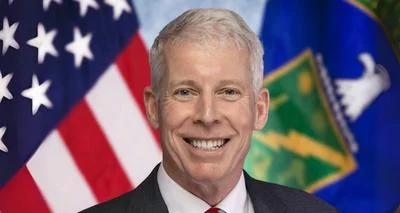The Congressional Record is a unique source of public documentation. It started in 1873, documenting nearly all the major and minor policies being discussed and debated.
“TRUST AND TREATY OBLIGATIONS TO INDIAN PEOPLE AND TRIBES” mentioning the Department of Interior was published in the Senate section on pages S4626-S4627 on April 29, 2004.
The publication is reproduced in full below:
TRUST AND TREATY OBLIGATIONS TO INDIAN PEOPLE AND TRIBES
Mr. DASCHLE. Mr President, an historic gathering took place in South Dakota last week. For 2 days, Indians and non-Indians came together to discuss how they could improve the schools attended by Indian children in South Dakota.
The South Dakota Indian Education Summit was sponsored by our Governor, Mike Rounds, and our state Education Department, working with tribal leaders and educators. It grew out of an extraordinary conference last October that I was proud to cosponsor. That Gathering and Healing of Nations conference brought Indians and non-Indians together to talk honestly about the issues that divide us, and the issues that unite us.
At the Indian Education Summit last week, most of the discussion focused on how to make sure the No Child Left Behind Act improves the schools Indian children attend. As we all know, concerns about No Child Left Behind are not limited to Indian Country. But they are especially acute in many parts of Indian Country, largely because of the Federal Government's long history of severely underfunding Indian education. I have heard from many Indian educators who tell me they are deeply concerned that the Federal Government will not provide Indian schools with the resources they need to meet the higher standards in No Child Left Behind. They are worried as well that the Bureau of Indian Affairs and the Department of Education may be placing too much emphasis on testing students and labeling schools--and not enough emphasis on helping schools correct problems. They're concerned about preserving native cultures and languages.
These are all legitimate concerns. We need to pay attention to them. That is why I have asked the Senate Indian Affairs Committee to hold hearings on how the No Child Left Behind Act is being implemented in Indian Country. I have not received a reply yet from the committee chairman, but I am hopeful that there will be agreement on the importance of holding such a hearing. I know he cares deeply about the need for the Federal Government to honor its trust and treaty obligations regarding education.
President Bush has proposed three Federal budgets since he signed the No Child Left Behind Act. All three have shortchanged No Child Left Behind. The President's proposed budget for next year--fiscal year 2005--underfunds the new law by $9.4 billion. Schools serving Indian children are among the oldest, poorest, and most crowded schools in America. They have been drastically underfunded for decades. The last thing children attending Indian schools need is to be denied the opportunities, resources, and good teachers the new law promises--and then have their schools labeled as ``failing.''
That is why, during debate last month on the budget resolution for next year, Democrats offered an amendment to fully fund No Child Left Behind for all schools, including BIA schools. Regrettably, Republicans defeated our amendment. But we are not giving up. We will continue to press to make sure No Child Left Behind is funded adequately and implemented sensibly in Indian Country, so that this Nation leaves no Indian child behind, either.
America also needs to face up to the massive school facilities problem in Indian Country. There is an overwhelming backlog of facility repair and construction projects for BIA schools, and the BIA estimates the cost of completing those projects at nearly $1.2 billion.
In 2000, when he was running for President, then-Governor Bush met with tribal leaders in New Mexico and promised to invest $1 billion to fix crumbling BIA schools. Yet the President's proposed budget for next year cuts funding for Indian school, reconstruction for the second year in a row. That is wrong.
Crow Creek Tribal Schools in Stephan, SD are among the nearly 200 BIA-funded and BIA-operated schools in the United States. Their buildings are typical of schools throughout Indian Country. They are crowded, crumbling, and outdated. Some of them date to the 1930s. Between 500 and 600 students attend classes in them. Two years ago, Crow Creek's middle school was condemned and replaced with modular trailers. An elementary school also need to be replaced. The high school gym is in such poor structural condition that it can only be used for limited purposes; the district has to rent gym space from other schools for basketball games. They don't know where they will hold their graduation this year.
Crow Creek Tribal Chairman Duane Big Eagle has been lobbying for money to fix the schools on the reservation for 25 years. Two months ago, he drove 4,000 miles to try to find someone in the Federal Government who would help him. He drove first to the BIA facilities and construction office in Albuquerque. When he found no help there, he drove to BIA headquarters in Washington, DC.
Senator Tim Johnson and I met with Chairman Big Eagle while he was in Washington, and I have since spoken with BIA officials about the Crow Creek schools. I am pleased to report that the BIA has agreed to provide $2.5 million for a new 17,000-square-foot gymnasium.
But there are still schools all over Indian Country where conditions would shock most Americans--schools with no heat and schools where the cold wind whips in through broken windows. Schools where trash cans are positioned in classrooms to catch the rain water that pours in through holes in the roofs.
The He Dog Tribal School in Rosebud is a two-story brick building built in the 1930s. Its ``library'' is three shelves of books on one bookcase.
A while back, leaders from the Dakota Area Consortium of Treaty Schools proposed a smart way to address the backlog of school construction needs in Indian Country. Their proposal called for the creation of a new Indian school-bonding authority that would use Federal dollars to leverage other funds.
We have been working with Senator Johnson to help create this authority, and we now have bipartisan support. We ought to consider it--and any other innovative ideas people may have to deal with the school-construction backlog--and then we must act.
It shouldn't take a tribal chairman driving thousands of miles for Indian children to be able to attend safe schools with adequate space and up-to-date books and computers. The right to attend a good school should be the birthright of every child in America. But Native American children have a special claim on this right.
Our Government has given its word, in treaties and laws, to provide education, health care, housing, and other basic necessities to Indian tribes and their members forever.
Education and other Federal programs serving Native Americans are not handouts; they are treaty obligations. They are installment payments the United States Government owes for land the tribes surrendered reluctantly more than a century ago. America has never even come close to meeting those obligations. You can see the legacy of this neglect in the harsh realities of life in Indian Country today: houses with no electricity, plumbing, or telephones. On some reservations in South Dakota, people live in homes with no running water; they have to haul water from 15 or 20 miles away. It is not unusual on reservations in South Dakota for 20 members of an extended family to share one small, three-bedroom home. Three hundred families on Pine Ridge are living in homes that are contaminated with black mold. The Pine Ridge Reservation needs 3,000 new houses just to meet the current demand.
During the depths of the Great Depression, 25 percent of Americans were unemployed. Today, on many reservations in South Dakota and other States, the unemployment rate is twice that high--or higher.
Native Americans live sicker and die younger than other Americans as a result of inadequate health care. Their higher rates of diabetes, heart disease, sudden infant death syndrome, tuberculosis, alcoholism, and many other serious health problems are the direct result of our Government's long history of dramatically underfunding Indian health. Our Government spends twice as much per person on health care for federal prisoners as it does on health care for Native Americans. I am still baffled by that statistic. We spend twice as much per person on health care for Federal prisoners in this country--$3,800 per capita--
as we do on the children on Indian reservations--$1,900 per capita this year. The rationing of health care at Indian Health clinics and hospitals is so severe that sick and injured people who are not in immediate danger of losing their life or a limb are routinely turned away and denied any care. This is immoral.
Tribal roads make up two-and-a-half percent of Federal roads in this country, yet tribes receive only one-half-of-one-percent of Federal road funding. The poor condition of many tribal roads is a significant reason that the rate of fatal traffic accidents on tribal roads is four times higher than the national average. It is also a major obstacle to economic opportunity in Indian Country.
These are just a few of the ways the Federal Government is failing to meet its trust and treaty obligations to Native people and tribes. Unfortunately, President Bush's proposed budget for next year would make things even worse. Dozens of programs serving Native Americans and Alaska Natives are flat-lined, reduced, or simply eliminated.
According to the National Congress of American Indians, the President's proposed budget cuts Indian hospital and clinic construction by 56 percent; Indian school construction by 19 percent; and tribal college funding by 11.5 percent. The tribal COPS program is slated to be cut by 20 percent, the tribal courts program by 26 percent, and the Indian Housing Loan Guarantee Program by 83 percent. The President's proposed budget also cuts $52 million from the BIA for tribal law enforcement, tribal roads, and Indian child welfare programs.
Earlier this month, BIA Assistant Secretary Dave Anderson shocked tribes with an announcement that BIA programs will be slashed another
$79 million in fiscal year 2006.
The president of the National Congress of American Indians, Tex Hall, has said, ``Asking us to somehow prioritize which programs in the BIA should be cut is like asking Indian Country to decide which child should go hungry, which elder should go unprotected, and which of those who need medical help should go untreated.''
Rather than do that, the National Congress of American Indians and BIA's Tribal Budget Advisory Council met recently with BIA officials in Washington over 2 days to develop an alternative budget. A tribal leader from my State, John Steele, president of the Oglala Sioux Tribe, is a member of that advisory council.
Assistant Secretary Anderson visited South Dakota reservations recently, so I know he is familiar with the staggering unmet needs of Indian Country. He surely must know that cuts such as those recommended by the White House will do real harm to people and communities that have already suffered greatly because of the policies and neglect of the Federal Government.
I hope Assistant Secretary Anderson will consider carefully the recommendations of the Tribal Budget Advisory Council as he prepares his budget request for fiscal year 2006. If he will take a strong stand for this government to meet its trust and treaty obligations, I know he will find many allies in Congress. I am one of them.
But Assistant Secretary Anderson and Interior Secretary Norton do not have to wait until the department completes its fiscal year 2006 budget proposal. They can do something today that will not cost a dime and will make a significant difference in the lives of thousands of Native Americans, especially children.
Three times now, the Federal judge hearing the Cobell v. Norton Indian trust case has had to order the Interior Department to shut down its computer system to protect individual Indian money accounts from hackers. Every time BIA has shut down computers in the Office of Special Trustee, it has shut down the computers serving Indian schools as well. The last time, the shutdown lasted for 5 days. Such disruptions cause serious problems for teachers, students, and school administrators.
In response to a recent letter from me, Interior Department officials said they did not choose to shut down the BIA school computers; they were forced to do so when the judge ordered the Indian trust computers shut down.
I have been told there is a simple solution: All Interior Department officials have to do is properly certify and verify to the court hearing the Cobell lawsuit that the BIA school computers are separate from the trust fund computers and protected from intrusion. Based on the department's certification and verification, if the trust fund computers ever have to be shut down again, BIA school computers will be spared. It is a simple step that can make a difference in the education of Indian children, and I urge the Interior Department to do it as soon as possible.
I also ask the Interior Department, the White House, and our Republican colleagues to work with us to come up with budgets that honor America's trust and treaty obligations to Indian people and tribes--next year, the year after that, and every year. This should not be a partisan issue.
The PRESIDENT pro tempore. The Democratic leader's time has expired.
____________________








